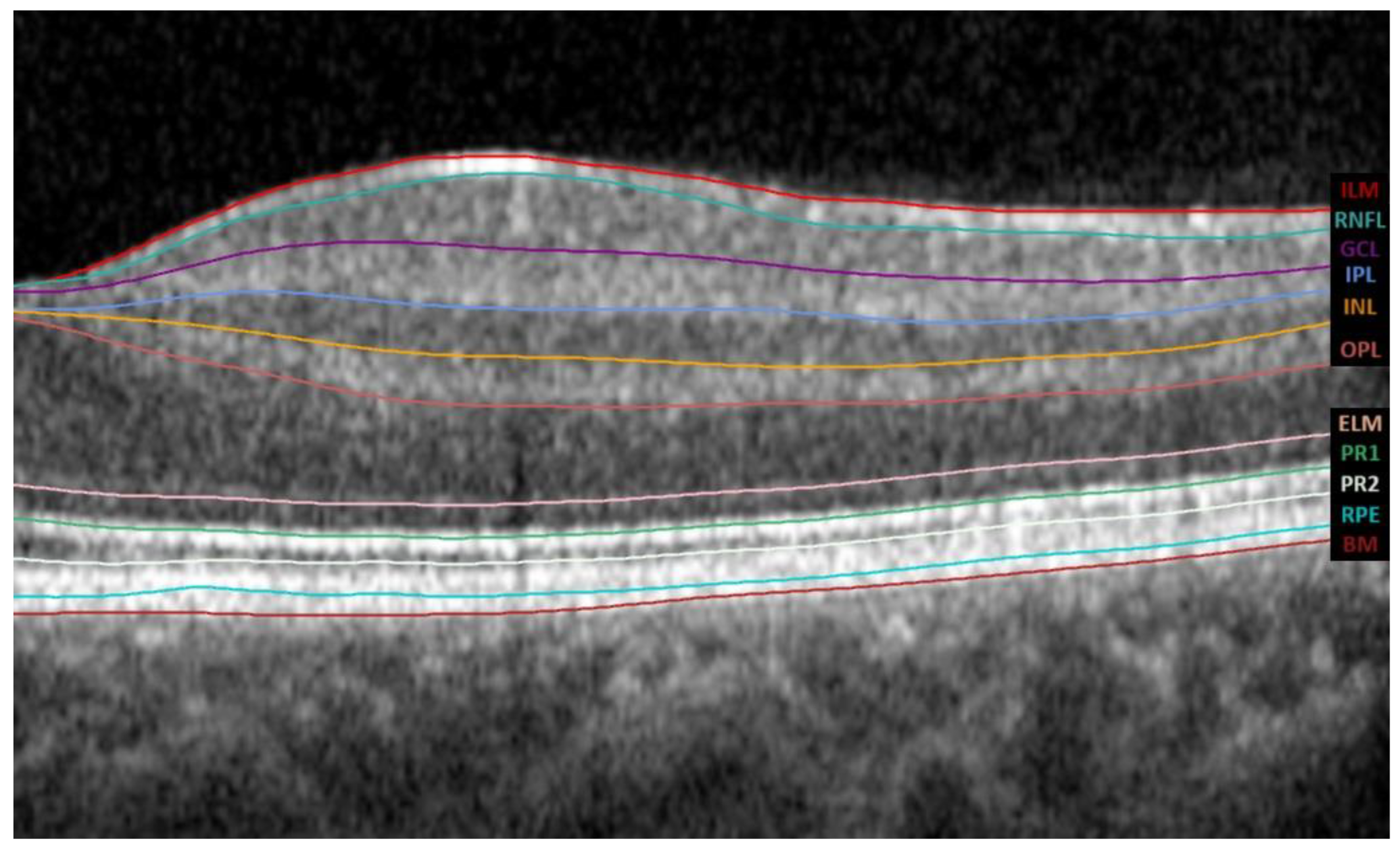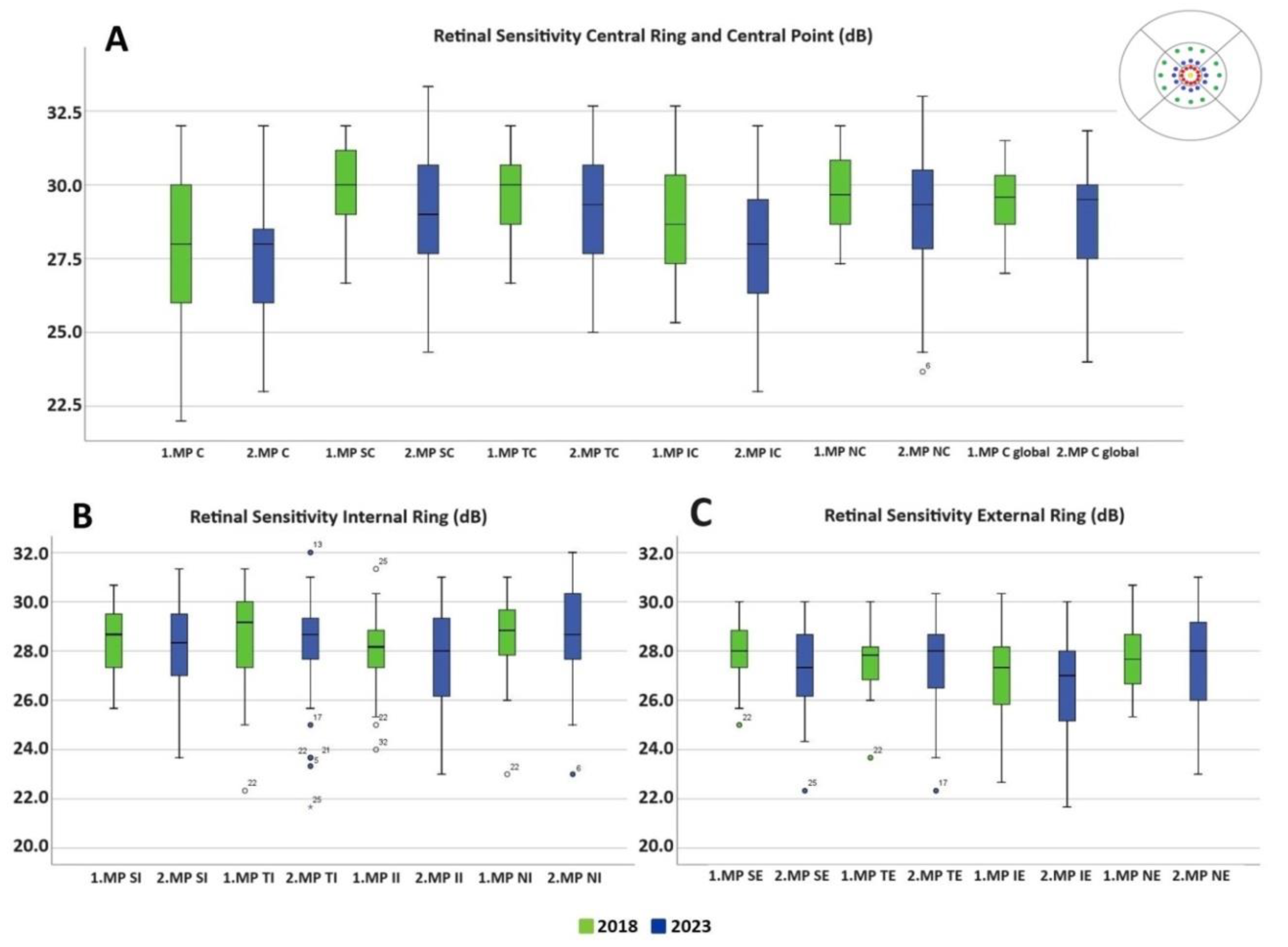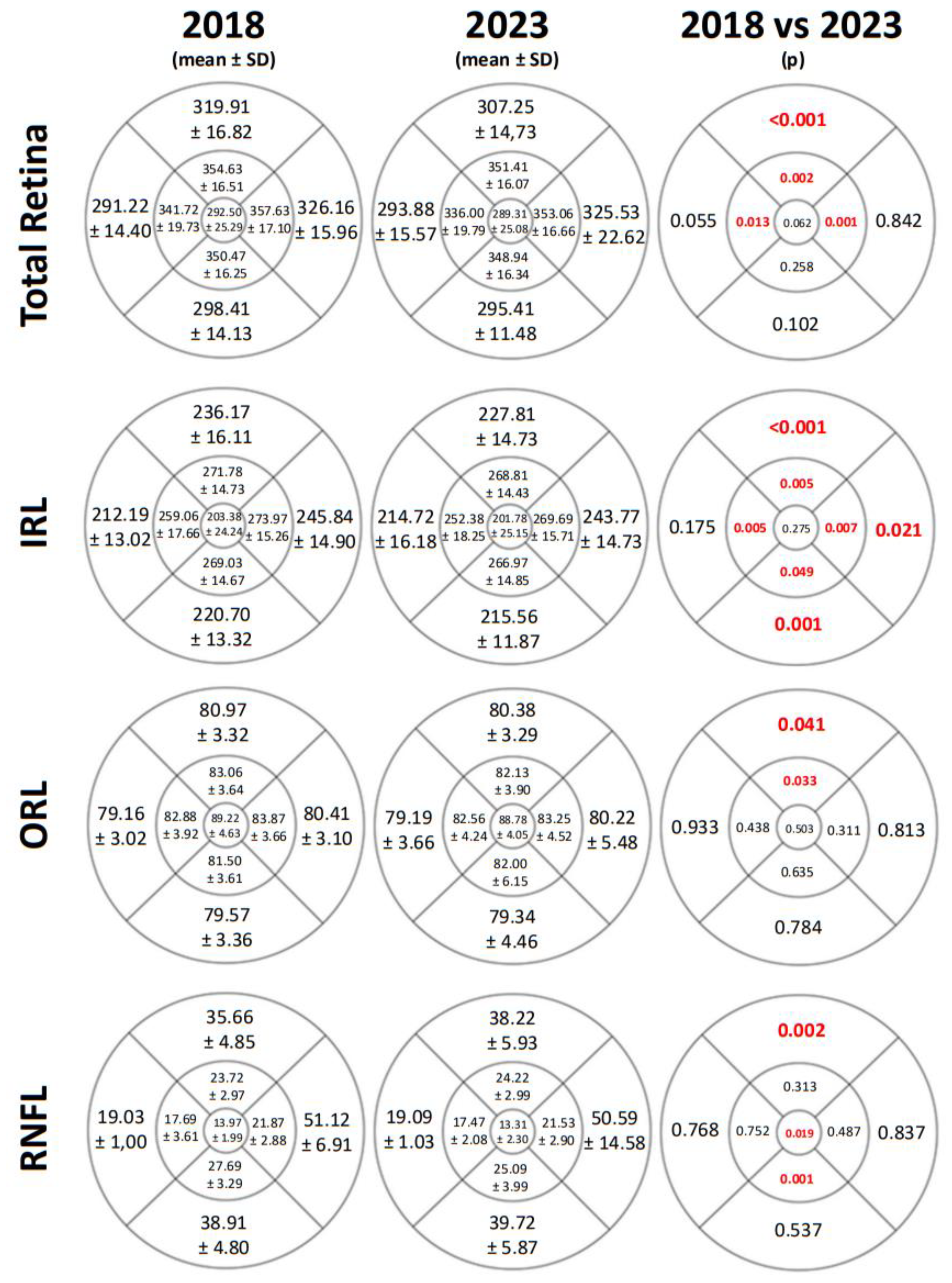Tracking Macular Sensitivity and Inner Retinal Thickness in Long-Term Type 1 Diabetes: A Five-Year Prospective Examination in Patients without Diabetic Retinopathy
Abstract
1. Introduction
2. Materials and Methods
2.1. Study Design
2.2. Study Protocol
2.3. Statistical Analysis
3. Results
3.1. Demographics
3.2. Macular Sensitivity Results and Relation with BCVA
3.3. OCT Thickness Analysis
4. Discussion
5. Conclusions
Author Contributions
Funding
Institutional Review Board Statement
Informed Consent Statement
Data Availability Statement
Acknowledgments
Conflicts of Interest
References
- Petersmann, A.; Müller-Wieland, D.; Müller, U.A.; Landgraf, R.; Nauck, M.; Freckmann, G.; Heinemann, L.; Schleicher, E. Definition, Classification and Diagnosis of Diabetes Mellitus. Exp. Clin. Endocrinol. Diabetes 2019, 127, S1–S7. [Google Scholar] [CrossRef] [PubMed]
- International Diabetes Federation (IDF). International Diabetes Federation, 10th ed.; IDF: Brussels, Belgium, 2021; ISBN 9782930229980. [Google Scholar]
- Saeedi, P.; Petersohn, I.; Salpea, P.; Malanda, B.; Karuranga, S.; Unwin, N.; Colagiuri, S.; Guariguata, L.; Motala, A.A.; Ogurtsova, K.; et al. Global and regional diabetes prevalence estimates for 2019 and projections for 2030 and 2045: Results from the International Diabetes Federation Diabetes Atlas, 9(th) edition. Diabetes Res. Clin. Pract. 2019, 157, 107843. [Google Scholar] [CrossRef] [PubMed]
- Solomon, S.D.; Chew, E.; Duh, E.J.; Sobrin, L.; Sun, J.K.; VanderBeek, B.L.; Wykoff, C.C.; Gardner, T.W. Diabetic Retinopathy: A Position Statement by the American Diabetes Association. Diabetes Care 2017, 40, 412–418. [Google Scholar] [CrossRef] [PubMed]
- Wolter, J.R. Diabetic Retinopathy. Am. J. Ophthalmol. 1961, 51, 1123/251–1141/269. [Google Scholar] [CrossRef]
- Ciulla, T.A.; Amador, A.G.; Zinman, B. Diabetic Retinopathy and Diabetic Macular Edema: Pathophysiology, screening, and novel therapies. Diabetes Care 2003, 26, 2653–2664. [Google Scholar] [CrossRef]
- Bloodworth, J.M.J. Diabetic retinopathy. Diabetes 1962, 11, 1–22. [Google Scholar]
- Pinilla, I.; Idoipe, M.; Perdices, L.; Sanchez-Cano, A.; Acha, J.; Lopez-Galvez, M.I.; Cuenca, N.; Abecia, E.; Orduna-Hospital, E. Changes in total and inner retinal thicknesses in type 1 diabetes with no retinopathy after 8 years of follow-up. Retina 2020, 40, 1379–1386. [Google Scholar] [CrossRef]
- Orduna-Hospital, E.; Otero-Rodríguez, J.; Perdices, L.; Sánchez-Cano, A.; Boned-Murillo, A.; Acha, J.; Pinilla, I. Microperimetry and optical coherence tomography changes in type-1 diabetes mellitus without retinopathy. Diagnostics 2021, 11, 136. [Google Scholar] [CrossRef]
- Chai, Q.; Yao, Y.; Guo, C.; Lu, H.; Ma, J. Structural and functional retinal changes in patients with type 2 diabetes without diabetic retinopathy. Ann. Med. 2022, 54, 1816–1825. [Google Scholar] [CrossRef]
- Care, D.; Suppl, S.S. Microvascular complications and foot care: Standards of medical care in diabetes—2021. Diabetes Care 2021, 44, S151–S167. [Google Scholar] [CrossRef]
- Sun, J.K.; Keenan, H.A.; Cavallerano, J.D.; Asztalos, B.F.; Schaefer, E.J.; Sell, D.R.; Strauch, C.M.; Monnier, V.M.; Doria, A.; Aiello, L.P.; et al. Protection from retinopathy and other complications in patients with type 1 diabetes of extreme duration: The Joslin 50-year medalist study. Diabetes Care 2011, 34, 968–974. [Google Scholar] [CrossRef] [PubMed]
- Meleppat, R.K.; Ronning, K.E.; Karlen, S.J.; Burns, M.E.; Pugh, E.N.; Zawadzki, R.J. In vivo multimodal retinal imaging of disease-related pigmentary changes in retinal pigment epithelium. Sci. Rep. 2021, 11, 16252. [Google Scholar] [CrossRef] [PubMed]
- Fernández-Espinosa, G.; Boned-Murillo, A.; Orduna-Hospital, E.; Díaz-Barreda, M.D.; Sánchez-Cano, A.; Bielsa-Alonso, S.; Acha, J.; Pinilla, I. Retinal Vascularization Abnormalities Studied by Optical Coherence Tomography Angiography (OCTA) in Type 2 Diabetic Patients with Moderate Diabetic Retinopathy. Diagnostics 2022, 12, 379. [Google Scholar] [CrossRef]
- Csaky, K.G.; Patel, P.J.; Sepah, Y.J.; Birch, D.G.; Do, D.V.; Ip, M.S.; Guymer, R.H.; Luu, C.D.; Gune, S.; Lin, H.; et al. Microperimetry for geographic atrophy secondary to age-related macular degeneration. Surv. Ophthalmol. 2019, 64, 353–364. [Google Scholar] [CrossRef] [PubMed]
- Ortiz-Zuñiga, A.M.; Rojano Toimil, A.; Rahnama, K.; Lainez, E.; Raguer, N.; Simó-Servat, O.; Hernández, C.; Simó, R.; Ciudin, A. Retinal sensitivity and gaze fixation evaluated by microperimetry in subjects with type 2 diabetes: Two independent parameters that explore different neuronal circuits. J. Endocrinol. Investig. 2023, 46, 1875–1880. [Google Scholar] [CrossRef]
- Seiple, W.; Rosen, R.B.; Castro-Lima, V.; Garcia, P.M.T. The physics and psychophysics of microperimetry. Optom. Vis. Sci. 2012, 89, 1182–1191. [Google Scholar] [CrossRef]
- Liu, H.; Bittencourt, M.G.; Wang, J.; Sepah, Y.J.; Ibrahim-Ahmed, M.; Rentiya, Z.; Jang, H.S.K.; Moradi, A.; Nguyen, Q.D. Retinal sensitivity is a valuable complementary measurement to visual acuity—A microperimetry study in patients with maculopathies. Graefe’s Arch. Clin. Exp. Ophthalmol. 2015, 253, 2137–2142. [Google Scholar] [CrossRef]
- Montesano, G.; Gervasoni, A.; Ferri, P.; Allegrini, D.; Migliavacca, L.; De Cillà, S.; Rossetti, L. Structure-function relationship in early diabetic retinopathy: A spatial correlation analysis with OCT and microperimetry. Eye 2017, 31, 931–939. [Google Scholar] [CrossRef]
- Pinilla, I.; Sanchez-Cano, A.; Ferreras, A.; Acha, J.; Pérez-García, D.; Ibañez-Alperte, J.; Abecia, E. Retinal Sensitivity in Patients with Type I Diabetes without Retinopathy or with Minor Retinal Changes. Exp. Clin. Endocrinol. Diabetes 2016, 124, 613–617. [Google Scholar] [CrossRef]
- Orduna-Hospital, E.; Sanchez-Cano, A.; Perdices, L.; Acha, J.; Lopez-Alaminos, E.M.; Pinilla, I. Changes in retinal layers in type 1 diabetes mellitus without retinopathy measured by spectral domain and swept source OCTs. Sci. Rep. 2021, 11, 10427. [Google Scholar] [CrossRef]
- Shah, M.; Farooq, A.; Tariq, Y. Relationship Between Glycosylated Hemoglobin Levels and Contrast Sensitivity in People with Type 2 Diabetes Mellitus Without Diabetic Retinopathy. Turkish J. Ophthalmol. 2022, 52, 394–399. [Google Scholar] [CrossRef] [PubMed]
- Silva-Viguera, M.C.; García-Romera, M.C.; Bautista-Llamas, M.J. Contrast sensitivity function under three light conditions in patients with type 1 diabetes mellitus without retinopathy: A cross-sectional, case–control study. Graefe’s Arch. Clin. Exp. Ophthalmol. 2023, 261, 2497–2505. [Google Scholar] [CrossRef]
- Altmann, C.; Schmidt, M.H.H. The role of microglia in diabetic retinopathy: Inflammation, microvasculature defects and neurodegeneration. Int. J. Mol. Sci. 2018, 19, 110. [Google Scholar] [CrossRef]
- McAnany, J.J.; Persidina, O.S.; Park, J.C. Clinical electroretinography in diabetic retinopathy: A review. Surv. Ophthalmol. 2022, 67, 712–722. [Google Scholar] [CrossRef] [PubMed]
- Zhu, D.D.; Wu, X.; Cheng, X.X.; Ding, N. Time in range as a useful marker for evaluating retinal functional changes in diabetic retinopathy patients. Int. J. Ophthalmol. 2023, 16, 915–920. [Google Scholar] [CrossRef]
- Park, J.C.; Chen, Y.-F.; Liu, M.; Liu, K.; McAnany, J.J. Structural and Functional Abnormalities in Early-stage Diabetic Retinopathy. Curr. Eye Res. 2020, 45, 975–985. [Google Scholar] [CrossRef]
- Molina-Martín, A.; Piñero, D.P.; Pérez-Cambrodí, R.J. Normal values for microperimetry with the MAIA microperimeter: Sensitivity and fixation analysis in healthy adults and children. Eur. J. Ophthalmol. 2017, 27, 607–613. [Google Scholar] [CrossRef] [PubMed]
- Fujiwara, A.; Shiragami, C.; Manabe, S.; Izumibata, S.; Murata, A.; Shiraga, F. Normal values of retinal sensitivity determined by macular integrity assessment. Nippon. Ganka Gakkai Zasshi 2014, 118, 15–21. [Google Scholar]
- Sacconi, R.; Lamanna, F.; Borrelli, E.; Mulinacci, G.; Casaluci, M.; Gelormini, F.; Carnevali, A.; Querques, L.; Zerbini, G.; Bandello, F.; et al. Morphofunctional analysis of the retina in patients with type 1 diabetes without complications after 30 years of disease. Sci. Rep. 2020, 10, 206. [Google Scholar] [CrossRef]
- Sacconi, R.; Casaluci, M.; Borrelli, E.; Mulinacci, G.; Lamanna, F.; Gelormini, F.; Carnevali, A.; Querques, L.; Zerbini, G.; Bandello, F.; et al. Multimodal imaging assessment of vascular and neurodegenerative retinal alterations in type 1 diabetic patients without fundoscopic signs of diabetic retinopathy. J. Clin. Med. 2019, 8, 1409. [Google Scholar] [CrossRef]
- Ortiz-Zúñiga, Á.M.; Simó-Servat, O.; Rojano-Toimil, A.; Vázquez-de Sebastian, J.; Castellano-Tejedor, C.; Hernández, C.; Simó, R.; Ciudin, A. The gaze fixation assessed by microperimetry: A useful tool for the monitoring of the cognitive function in patients with type 2 diabetes. J. Pers. Med. 2021, 11, 698. [Google Scholar] [CrossRef] [PubMed]
- Zabel, K.; Zabel, P.; Suwala, K.; Gorczyca, A.; Jaworski, D.; Kaluzna, M.; Gebska-Toloczko, M.; Wnuk, K.; Buszko, K.; Kaluzny, J.J. Alterations in Fixation Indices in Primary Open-Angle Glaucoma by Microperimetry. J. Clin. Med. 2022, 11, 2368. [Google Scholar] [CrossRef] [PubMed]
- Boned-Murillo, A.; Diaz-Barreda, M.D.; Ferreras, A.; Bartolomé-Sesé, I.; Orduna-Hospital, E.; Montes-Rodríguez, P.; Ascaso, J.; Pinilla, I. Structural and functional findings in patients with moderate diabetic retinopathy. Graefe’s Arch. Clin. Exp. Ophthalmol. 2021, 259, 3625–3635. [Google Scholar] [CrossRef] [PubMed]
- Wang, J.W.; Jie, C.H.; Tao, Y.J.; Meng, N.; Hu, Y.C.; Wu, Z.Z.; Cai, W.J.; Gong, X.M. Macular integrity assessment to determine the association between macular microstructure and functional parameters in diabetic macular edema. Int. J. Ophthalmol. 2018, 11, 1185–1191. [Google Scholar] [CrossRef] [PubMed]
- Boned-Murillo, A.; Fernández-Espinosa, G.; Orduna-Hospital, E.; Díaz-Barreda, M.D.; Sánchez-Cano, A.; Sopeña-Pinilla, M.; Bielsa-Alonso, S.; Pinilla, I. Changes in Inner Retina Thickness and Macular Sensitivity in Patients with Type 2 Diabetes with Moderate Diabetic Retinopathy. Biomedicines 2023, 11, 2972. [Google Scholar] [CrossRef]
- Horie, S.; Giulia, C.; Esmaeilkhanian, H.; Sadda, S.R.; Cheung, C.M.G.; Ham, Y.; Chang, A.; Takahashi, T.; Ohno-Matsui, K. Microperimetry in Retinal Diseases. Asia-Pacific J. Ophthalmol. 2023, 12, 211–227. [Google Scholar] [CrossRef]
- Scuderi, L.; Gattazzo, I.; de Paula, A.; Iodice, C.M.; Di Tizio, F.; Perdicchi, A. Understanding the role of microperimetry in glaucoma. Int. Ophthalmol. 2022, 42, 2289–2301. [Google Scholar] [CrossRef]
- Ciudin, A.; Simó-Servat, O.; Hernández, C.; Arcos, G.; Diego, S.; Sanabria, Á.; Sotolongo, Ó.; Hernández, I.; Boada, M.; Simó, R. Retinal microperimetry: A new tool for identifying patients with type 2 diabetes at risk for developing Alzheimer disease. Diabetes 2017, 66, 3098–3104. [Google Scholar] [CrossRef]
- Ciudin, A.; Ortiz-Zuñiga, A.M.; Fidilio, E.; Romero, D.; Sánchez, M.; Comas, M.; Gonzalez, O.; Vilallonga, R.; Simó-Servat, O.; Hernández, C.; et al. Retinal microperimetry: A useful tool for detecting insulin resistance-related cognitive impairment in morbid obesity. J. Clin. Med. 2019, 8, 2181. [Google Scholar] [CrossRef]
- Shalimova, A.; Graff, B.; Gasecki, D.; Wolf, J.; Sabisz, A.; Szurowska, E.; Jodzio, K.; Narkiewicz, K. Cognitive dysfunction in type 1 diabetes mellitus. J. Clin. Endocrinol. Metab. 2019, 104, 2239–2249. [Google Scholar] [CrossRef]
- Han, R.C.; Jolly, J.K.; Xue, K.; MacLaren, R.E. Effects of pupil dilation on MAIA microperimetry. Clin. Exp. Ophthalmol. 2017, 45, 489–495. [Google Scholar] [CrossRef] [PubMed]
- Barboni, M.T.S.; Szepessy, Z.; Ventura, D.F.; Németh, J. Individual test point fluctuations of macular sensitivity in healthy eyes and eyes with age-related macular degeneration measured with microperimetry. Transl. Vis. Sci. Technol. 2018, 7, 25. [Google Scholar] [CrossRef]
- Lindenmuth, K.A.; Skuta, G.L.; Rabbani, R.; Musch, D.C.; Bergstrom, T.J. Effects of pupillary dilation on automated perimetry in normal patients. Ophthalmology 1990, 97, 367–370. [Google Scholar] [CrossRef]
- Kudrna, G.R.; Stanley, M.A.; Remington, L.A. Pupillary dilation and its effects on automated perimetry results. J. Am. Optom. Assoc. 1995, 66, 675–680. [Google Scholar]
- Park, H.J.; Youn, D.H. Quantitative analysis of changes of automated perimetric thresholds after pupillary dilation and induced myopia in normal subjects. Korean J. Ophthalmol. 1994, 8, 53–60. [Google Scholar] [CrossRef]
- Wu, Z.; Ayton, L.N.; Guymer, R.H.; Luu, C.D. Intrasession test-retest variability of microperimetry in age-related macular degeneration. Investig. Ophthalmol. Vis. Sci. 2013, 54, 7378–7385. [Google Scholar] [CrossRef] [PubMed]
- Gundogan, F.C.; Akay, F.; Uzun, S.; Yolcu, U.; Çağıltay, E.; Toyran, S. Early Neurodegeneration of the Inner Retinal Layers in Type 1 Diabetes Mellitus. Ophthalmologica 2016, 235, 125–132. [Google Scholar] [CrossRef] [PubMed]
- Ambiya, V.; Kumar, A.; Bhavaraj, V.R.; Sharma, V.; Sharma, N. Study of inner retinal neurodegeneration in Diabetes Mellitus using spectral domain optical coherence tomography. Eur. J. Ophthalmol. 2022, 32, 3074–3081. [Google Scholar] [CrossRef]
- Tiepei, Z.H.U.; Jin, M.A.; Yonghao, L.I.; Zheng, Z. Association between retinal neuronal degeneration and visual function impairment in type 2 diabetic patients without diabetic retinopathy. Sci. China Life Sci. 2015, 58, 550–555. [Google Scholar] [CrossRef]
- Montesano, G.; Ometto, G.; Higgins, B.E.; Das, R.; Graham, K.W.; Chakravarthy, U.; McGuiness, B.; Young, I.S.; Kee, F.; Wright, D.M.; et al. Evidence for structural and functional damage of the inner retina in diabetes with no diabetic retinopathy. Investig. Ophthalmol. Vis. Sci. 2021, 62, 35. [Google Scholar] [CrossRef]
- Carbonell, M.; Alonso, N.; Castelblanco, E.; Real, J.; Ramírez-Morros, A.; Simó, R.; Hernández, C.; Jurjo, C.; Traveset, A.; Valldeperas, X.; et al. Assessment of inner retinal layers and choroidal thickness in type 1 diabetes mellitus: A cross-sectional study. J. Clin. Med. 2019, 8, 1412. [Google Scholar] [CrossRef] [PubMed]
- Harwerth, R.S.; Wheat, J.L.; Fredette, M.J.; Anderson, D.R. Linking structure and function in glaucoma. Prog. Retin. Eye Res. 2010, 29, 249–271. [Google Scholar] [CrossRef] [PubMed]
- Ezhilvendhan, K.; Shenoy, A.; Rajeshkannan, R.; Balachandrachari, S.; Sathiyamoorthy, A. Evaluation of Macular Thickness, Retinal Nerve Fiber Layer and Ganglion Cell Layer Thickness in Patients among Type 2 Diabetes Mellitus Using Optical Coherence Tomography. J. Pharm. Bioallied Sci. 2021, 13, S1055–S1061. [Google Scholar] [CrossRef] [PubMed]
- Bhaskaran, A.; Babu, M.; Sudhakar, N.A.; Kudlu, K.P.; Shashidhara, B.C. Study of retinal nerve fiber layer thickness in diabetic patients using optical coherence tomography. Indian J. Ophthalmol. 2023, 71, 920–926. [Google Scholar] [CrossRef] [PubMed]
- Wang, X.N.; Cai, X.; Li, T.T.; Long, D.; Wu, Q. Peripapillary vessel density and retinal nerve fiber layer thickness changes in early diabetes retinopathy. Int. J. Ophthalmol. 2022, 15, 1488–1495. [Google Scholar] [CrossRef]
- Kern, T.S.; Engerman, R.L. Vascular lesions in diabetes are distributed non-uniformly within the retina. Exp. Eye Res. 1995, 60, 545–549. [Google Scholar] [CrossRef]





| 2018 | 2023 | ||
|---|---|---|---|
| DM1 Patients | Mean ± SD | Mean ± SD | p-Value |
| HbA1c (%) | 7.59 ± 1.01 | 7.55 ± 0.90 | 0.420 |
| Creatinine (mg/dL) | 0.80 ± 0.12 | 0.77 ± 0.12 | 0.382 |
| Total Cholesterol (mg/dL) | 194.50 ± 35.63 | 195.80 ± 32.35 | 0.355 |
| HDL Cholesterol (mg/dL) | 57.04 ± 14.04 | 57.57 ± 13.55 | 0.411 |
| LDL Cholesterol (mg/dL) | 120.21 ± 27.65 | 121.63 ± 24.82 | 0.340 |
| Microalbumin in Urine (mg) | 9.04 ± 7.85 | 6.78 ± 7.20 | 0.476 |
| 2018 | 2023 | ||
|---|---|---|---|
| DM1 Patients | Mean ± SD | Mean ± SD | p-Value |
| BCVA (LogMAR) | −0.14 ± 0.12 | 0.03 ± 0.07 | <0.001 |
| SE (D) | −0.77 ± 1.69 | −0.64 ± 1.68 | 0.179 |
| AL (mm) | 23.72 ± 1.11 | 23.83 ± 1.16 | 0.226 |
| IOP (mmHg) | 17.31 ± 2.68 | 16.88 ± 1.86 | 0.174 |
| 2018 | 2023 | ||
|---|---|---|---|
| MAIA Areas | Mean (dB) ± SD | Mean (dB) ± SD | p-Value |
| SE | 27.94 ± 1.13 | 27.25 ± 1.87 | 0.072 |
| TE | 27.61 ± 1.24 | 27.23 ± 2.03 | 0.340 |
| IE | 26.96 ± 1.83 | 26.36 ± 2.19 | 0.129 |
| NE | 27.88 ± 1.32 | 27.45 ± 2.34 | 0.289 |
| SI | 28.39 ± 1.39 | 28.23 ± 1.84 | 0.697 |
| TI | 28.44 ± 1.91 | 28.03 ± 2.37 | 0.384 |
| II | 28.17 ± 1.64 | 27.64 ± 2.19 | 0.244 |
| NI | 28.56 ± 1.61 | 28.67 ± 2.15 | 0.810 |
| C | 27.56 ± 2.50 | 27.50 ± 2.49 | 0.893 |
| SC | 29.68 ± 1.60 | 28.94 ± 2.12 | 0.062 |
| TC | 29.40 ± 1.86 | 29.07 ± 2.02 | 0.415 |
| IC | 28.63 ± 1.97 | 27.90 ± 2.36 | 0.078 |
| NC | 29.62 ± 1.49 | 28.86 ± 2.35 | 0.121 |
| C Global | 29.32 ± 1.35 | 28.73 ± 1.93 | 0.079 |
| 2018 | 2023 | ||
|---|---|---|---|
| MAIA Parameter | Mean ± SD | Mean ± SD | p-Value |
| Macular integrity (dB) | 28.80 ± 25.58 | 42.64 ± 34.37 | 0.045 |
| Average threshold (dB) | 28.43 ± 1.27 | 27.99 ± 1.87 | 0.168 |
| Fixation stability P1 (%) | 90.97 ± 14.07 | 97.63 ± 3.31 | 0.313 |
| Fixation stability P2 (%) | 97.84 ± 4.67 | 97.63 ± 3.31 | 0.815 |
| BCEA 63 area (°2) | 1.18 ± 1.41 | 1.19 ± 1.20 | 0.965 |
| BCEA 63 angle (°) | −7.10 ± 66.36 | 14.60 ± 63.49 | 0.198 |
| BCEA 95 area (°2) | 2.53 ± 7.03 | 3.56 ± 3.61 | 0.408 |
| BCEA 95 angle (°) | −7.87 ± 66.76 | 14.60 ± 63.49 | 0.184 |
| Fixation loses (%) | 2.03 ± 6.46 | 4.53 ± 9.62 | 0.208 |
Disclaimer/Publisher’s Note: The statements, opinions and data contained in all publications are solely those of the individual author(s) and contributor(s) and not of MDPI and/or the editor(s). MDPI and/or the editor(s) disclaim responsibility for any injury to people or property resulting from any ideas, methods, instructions or products referred to in the content. |
© 2024 by the authors. Licensee MDPI, Basel, Switzerland. This article is an open access article distributed under the terms and conditions of the Creative Commons Attribution (CC BY) license (https://creativecommons.org/licenses/by/4.0/).
Share and Cite
Fernández-Espinosa, G.; Orduna-Hospital, E.; Sopeña-Pinilla, M.; Arias-Álvarez, M.; Boned-Murillo, A.; Díaz-Barreda, M.D.; Sánchez-Cano, A.; Pinilla, I. Tracking Macular Sensitivity and Inner Retinal Thickness in Long-Term Type 1 Diabetes: A Five-Year Prospective Examination in Patients without Diabetic Retinopathy. Life 2024, 14, 1152. https://doi.org/10.3390/life14091152
Fernández-Espinosa G, Orduna-Hospital E, Sopeña-Pinilla M, Arias-Álvarez M, Boned-Murillo A, Díaz-Barreda MD, Sánchez-Cano A, Pinilla I. Tracking Macular Sensitivity and Inner Retinal Thickness in Long-Term Type 1 Diabetes: A Five-Year Prospective Examination in Patients without Diabetic Retinopathy. Life. 2024; 14(9):1152. https://doi.org/10.3390/life14091152
Chicago/Turabian StyleFernández-Espinosa, Guisela, Elvira Orduna-Hospital, María Sopeña-Pinilla, Marta Arias-Álvarez, Ana Boned-Murillo, María Dolores Díaz-Barreda, Ana Sánchez-Cano, and Isabel Pinilla. 2024. "Tracking Macular Sensitivity and Inner Retinal Thickness in Long-Term Type 1 Diabetes: A Five-Year Prospective Examination in Patients without Diabetic Retinopathy" Life 14, no. 9: 1152. https://doi.org/10.3390/life14091152
APA StyleFernández-Espinosa, G., Orduna-Hospital, E., Sopeña-Pinilla, M., Arias-Álvarez, M., Boned-Murillo, A., Díaz-Barreda, M. D., Sánchez-Cano, A., & Pinilla, I. (2024). Tracking Macular Sensitivity and Inner Retinal Thickness in Long-Term Type 1 Diabetes: A Five-Year Prospective Examination in Patients without Diabetic Retinopathy. Life, 14(9), 1152. https://doi.org/10.3390/life14091152







